Editorial
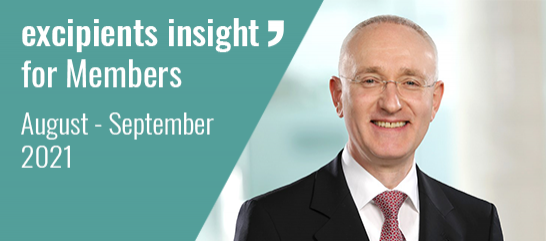
Dear Members,
We start this edition with hope, as we see that life as we knew it is knocking at our doors! Gradually we’re returning to our workplaces and it’s so pleasing to see our colleagues in 3D again. Meetings and events are slowly but surely (?) becoming live events once more.
At the beginning of this month, we attended our first face-to-face experience in 21 months. With our sister association, EXCiPACT, we exhibited and presented at Making Pharmaceuticals in Coventry, UK, on 5-6 October.
You can learn more about the happenings at Making Pharmaceuticals inside but meanwhile, for sure, it’s good to be back!
Talking about events, we’re actively working on our next live Excipients Forum in 2022 where we will celebrate IPEC Europe’s 30th Anniversary and the 10th Anniversary of EXCiPACT. We’re already 30 years old and our ‘raison d’être’ is stronger than ever. Going beyond the age-old paradigm that excipients are just ‘fillers’, excipients as lipoid nanoparticles played are critical role in the development of Covid 19 mRNA vaccines. We need to keep driving this message home to get full recognition of the role that excipients can play and deserve. Keep an eye on our website, our LinkedIn page and on your inbox, as we’ll soon send the ‘Save the Date’ invitations for this must-attend event.
Despite the circumstances, IPEC Europe is making progress on several hot topics. We are putting together a Task Force on Nanoparticles as the current focus on nanomaterials could have significant impact on many commonly used excipients. If you are interested to join, please contact the Secretariat as soon as possible. On the Titanium Dioxide front, IPEC Europe wrote to both EMA and MHRA during the summer, communicating our concerns with the potential delisting of this important material as a colourant approved for pharmaceutical use. Co-processed excipients (CPEs) are another subject attracting a lot of attention now. There’s a lot of discussion as to what exactly constitutes a CPE and not to confuse it with excipient mixtures or indeed drug product intermediates. We believe IPEC’s position is clear on this and so we’re considering possible avenues to clarify this. A group of experts is analysing the situation and gathering experiences from member companies. Ultimately, IPEC Europe will approach the regulators to discuss this subject.
Albeit virtually, the IPEC Europe Board and the Quality & Regulatory Affairs Committee Chair met with EDQM recently and were introduced to the new Director, Dr Petra Doerr. As always, the exchange was open and stimulating so please look at the report in this issue.
Looking forward to December, IPEC Europe through IPEC Federation will attend the annual meeting with PDG (Pharmacopoeial Discussion Group). We’d love to hear from our members as to what you think should be on this agenda so don’t hesitate to send us suggestions on what you think IPEC should be discussing with PDG.
Finally, we held our third quarterly ‘catch-up’ at the end of September and we’re very pleased with all the sessions we’ve run this year judged by the high attendance. As something new this year, these ‘rendez-vous’ are to provide more interactive communication on IPEC Europe and what we’re doing - do you agree that these are worthwhile and add value to you as a member? Why not let us know at info@ipec-europe.org.
This edition covers many other subjects, so we wish you good reading! And we’re always looking to improve Excipients Insight and would welcome your ideas … so don’t be shy, get in touch!
Until the next time,
Frithjof Holtz
IPEC Europe Chair
Titanium Dioxide: updates
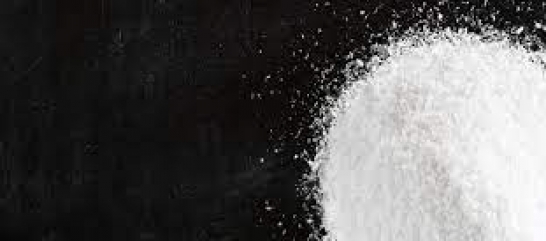
In the latest Excipient Insight, we reported that the long-awaited final EFSA opinion on E171 Titanium Dioxide concluded that it could no longer be considered safe as a food additive.
The European Commission ended the interservice consultation, and EMA has communicated its position to them. The Standing Committee on Plants, Animals, Food and Feed (SCoPAFF) met on 28 September to consider the European Commission draft implementing act relating to the removal of Titanium Dioxide - E171 (TiO2) – from the list of authorised colouring food additives. The PAFF will evaluate the act and provide an opinion. If the SCoPAFF gives a positive opinion, then a scrutiny period of three months will start. If at the end of that period, neither the EU Parliament nor the EU Council had objected, then the Commission will definitely adopt the proposed amendments to the Annexes II and III to Regulation (EC) No 1333/2008.
Please note that the Commission draft mentions the situation of titanium dioxide used as an excipient. Here is an extract:
“(…)On the basis of the EMA scientific analysis, and in order to avoid shortages of medicinal products that could have impacts on public health, titanium dioxide (E 171) should remain provisionally on the list of authorised additives to allow its use in medicinal products as a colour, pending the development of adequate alternatives to replace it while ensuring the quality, safety and efficacy of the medicinal products concerned. During this time, titanium dioxide (E 171) should however be included in the list of colours that may not be sold directly to consumers.(…)”
“(…It is of critical importance that the pharmaceutical industry makes any possible efforts to accelerate the research and development of alternatives that would be used as a replacement for titanium dioxide (E 171) in medicinal products, and to submit the necessary variation to the terms of the marketing authorisations concerned. In the absence of such efforts, competent authorities may request the concerned stakeholders to submit objective and verifiable reason explaining the non-feasibility of the replacement.(…)”
“(…)The Commission is committed to review the necessity to maintain titanium dioxide (E 171) or otherwise delete it from the Union list of food additives for exclusive use as a colour in medicinal products within three years after the date of entering into force of this Regulation. This review should be based on an updated assessment of the EMA to be performed before 1 April 2024.(…)”
IPEC Europe is monitoring the situation; further updates will be provided during committee meetings and in future editions of Excipients Insight.
Updates from the IPEC Europe Board and the QRAC Committee
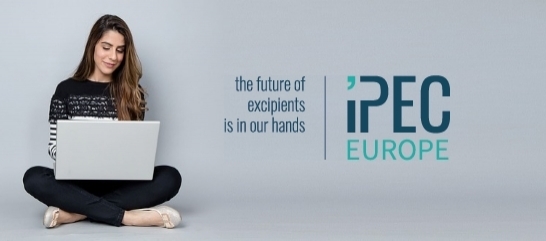
IPEC Europe Board
The IPEC Europe Board met virtually on 21 September to discuss on the objectives and the progress of current projects. A membership survey will be issued at the end of October to gain member’s input for the 2022 objectives. Proposals for a redesigned membership fee structure are being developed, in a bid to attract new members and consider small companies. Plans to organise IPEC Europe Forum 2022 as a hybrid event are being developed, and a LinkedIn campaign to celebrate the 30th Anniversary of the association and its dedicated messaging is being finalised.
The Board will reconvene on 25 November for the last meeting of the year.
Highlights of the latest Board meetings are available to all Members in the Member’s Lab. If you do not have access to the Member’s Lab, contact the Secretariat.
QRAC Committee
The QRAC Core Team met on 16 September to advance on the main objectives of the committee.
A compilation of known global positions on nanoparticles is now approved and available in the Member’s Lab and a task force is being formed (see dedicated article); the Lactose Interest Group’s efforts to develop an improved alpha/beta ratio assay method continue.
On microplastics, the comprehensive ‘aide memoire’ as to how members can be informed of the requirements and make ready for compliance is almost finalised.
The co-processed excipients task force is seeking volunteers: please contact the IPEC Europe Secretariat.
On regulatory activities, the evolution of the ban of titanium dioxide as a food additive is closely monitored, while Members are contributing to a consortium providing data to EFSA on iron oxide.
Members of the QRAC Core Team will reunite on 16 December to round off the year.
Highlights of the QRAC Core meetings are available to all Members in the Member’s Lab, under Members / Committee - QRAC - Minutes / 2021 – Highlights.
IPEC Europe meets EDQM
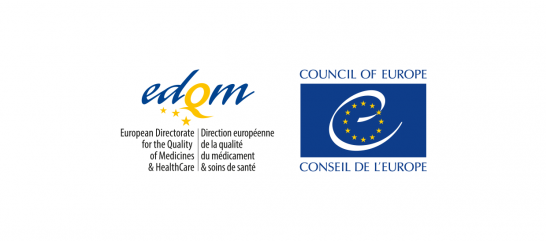
On 21 September, the IPEC Europe Board and the Quality & Regulatory Affairs Committee Chairs met virtually with EDQM representatives. It was an opportunity to be introduced to the new Director, Dr Petra Doerr. E Charton, Ph Eur Head of Division B, presented on the elimination of the rabbit pyrogen test from Ph Eur texts according to a timetable which will extend to 2026. This will allow transfers to in vitro tests already existing in the Ph Eur. On nitrites and nitrosamines, D Leutner, Ph Eur Head of Pharmaceutical Technology Section, commented that understanding the role of nitrites originating from excipients in generating nitrosamines in drug products is still in its infancy and as, yet EDQM has no specific plans for (excipient) monograph revision.
IPEC Europe noted that an industry consortium is compiling a data base ( LHASA ) of the nitrite levels observed in pharmaceutical excipients.
Upon a question of an IPEC Europe member, A Garnier-Poidevin, Ph Eur Scientific Administrator, reported that Polysorbates monographs -20, -40, -60, -80 are under revision to include a FRC section and will be published in PharmEuropa 33.4 by the end of this September (see dedicated article on EDQM)
On PDG’s activities, EDQM shared that PDG, as stewards of the Q4B guidelines has approached non-founding ICH members, including ChP, to understand the implementation status of harmonised general chapters.
IPEC Europe also relayed that recent experiences within both national and regional regulatory agencies continue to raise issues with the use of CPEs in drug products and their status as an excipient vs a finished product intermediate (in the drug manufacturing process). This trend could potentially jeopardise their selection by formulators which can create a barrier to innovation in medicines’ development. Equally, regulatory actions such as rejection of MAA’s and drug product-type GMP requirements may establish a precedent where enhanced conditions are applied to other types of excipients. EDQM is monitoring the situation and suggested that IPEC Europe approaches EMA to determine with whom it should engage to further dialogue on this topic.
Finally, IPEC Europe outlined our initiative to develop a multi-compendial compliance strategy to overcome the burden of multiple testing. The intent is to present a generalised approach for what is already commonplace in industry. EDQM informed attendees that it was working on a new chapter entitled 5.27 comparability testing of alternative methods which may be a good reference document for the IPEC Europe documents.
IPEC GDP Audit Guide
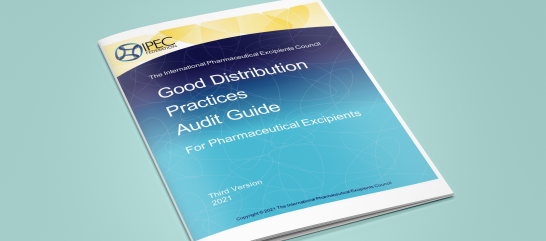
IPEC Federation announces the availability of the revised IPEC Good Distribution Practices Audit Guide for Pharmaceutical Excipients (Version 3, 2021).
The revised IPEC Federation Good Distribution Practices Audit Guide has been developed by a team consisting of members from IPEC Europe and IPEC-Americas. This document is a consolidation and revision of IPEC Europe’s GDP Audit guideline (2011) and IPEC-Americas GDP Audit Guide for North American distribution of pharmaceutical excipients (2011).
The IPEC Good Distribution Practices Audit guides have been proven as an important element in the supply chain management and control of pharmaceutical starting materials. The revised Audit Guide provides a comprehensive tool for companies auditing the supply chain of pharmaceutical excipients. Several incidents in the past were caused by a lack of supply chain security and inappropriate handling of pharmaceutical excipients. This has moved regulators, users, manufacturers and distributors to take action.
The revised GDP Audit Guide should be used in conjunction with the IPEC Good Distribution Practices Guide. It serves as a valuable tool to help the auditor conduct a complete audit of all relevant GDP principles for pharmaceutical excipients.
For the purpose of this document, “distributors” includes, for example, those parties involved in trade and distribution, re-processors, re-packagers, transport and warehousing companies, forwarding agents, brokers, traders, and suppliers other than the original manufacturer.
The revised IPEC GDP Audit Guide is available on the Member’s Lab as an exclusive preview for IPEC Europe Members.
A free-to-attend webinar will be held in early December – see the article on the webinars for further details.
Upcoming meeting with PDG: share your topics!

EDQM, the organising pharmacopoeia, has invited IPEC Federation for the annual Pharmacopoeial Discussion Group (PDG) meeting on Wednesday 1 December 2021. Once again, the meeting will be held remotely due to the pandemic situation. IPEC Europe will be represented by our Chair, Mr Frithjof Holtz and our Vice-Chair and President of IPEC Federation, Dr Frank Milek.
IPEC Federation will put together a proposed agenda for PDG’s consideration. You are invited to submit topics that you feel pertinent to discuss. We appreciate your ideas and proposals, please send them to the Secretariat: info@ipec-europe.org
Nanoparticles - Compilation document and call for volunteers
To take stock on the nano situation, some IPEC Europe members compiled a document summarising the current regulatory approaches to the nanoparticles in different regions.
The document is available on the Member’s Lab and is exclusive to IPEC Europe Members. To download it, click here: Compilation of current regulatory approaches to the nanoparticle in different regions
This work, but also the situation with titanium dioxide and the list published by the French Food Agency, ANSES, on nanomaterial in foods, led the Federation to move the topic higher in the priorities list. A Think tank will be created at IPEC Federation level when there will be task forces at national/regional level. The aim is to map the priorities relating to nanos and assess their impact on excipients.
An initial teleconference will be organised soon by IPEC Europe to identify the challenges and then create the task force. If you are interested please make yourself known to the Secretariat: info@ipec-europe.org
Ph.Eur.: Certification of Suitability - PharmEuropa 33.4

Certification of suitability: revised terms of reference and rules of procedure
A revised version of the terms of reference and rules of procedure for the Certification of suitability to the monographs of the European Pharmacopoeia (CEP) procedure has been adopted by the Certification Steering Committee and is available on the website of the European Directorate for the Quality of Medicines & HealthCare (EDQM): Terms of Reference and Rules of Procedure (PA/PH/CEP (01) 1, 12 R).
This revision was undertaken to clarify the title and certain working procedures, and to take into account organisational changes in the EDQM Certification of Substances Department.
Source: EDQM
Pharmeuropa 33.4 now published
The latest issue of Pharmeuropa 33.4 contains 41 drafts published for review and comments. The full list is available here. The deadline for comments is 31 September 2021.
European Health Union: towards a reform of EU pharmaceutical legislation
In late September, The European Commission has published a public consultation on the revision of the EU's pharmaceutical legislation. This is the latest step towards an ambitious reform as announced in the Pharmaceutical Strategy for Europe, adopted in November 2020.
The consultation, which will run for twelve weeks, until 21 December, will gather the views from both the general public and stakeholders to support the evaluation of and the impact assessment for the revision of the EU's pharmaceutical legislation. Today's development follows on from the public consultation conducted for the preparation of the Strategy itself.
Since the adoption of the Strategy, the Commission has been working on a number of actions in close cooperation with Member States' authorities, the European Medicines Agency and with stakeholders' organisations. A major flagship action is the revision of the general pharmaceutical legislation, foreseen for end 2022, which is also being supported by an ongoing study. Other flagship actions of the Strategy focus on Health Technology Assessment, EU Health Data Space, legislation on rare diseases and medicines for children and strengthening the continuity and security of supply of medicines in the EU.
This public consultation notably addresses:
- The performance of the EU's pharmaceutical legislation;
- Unmet medical needs;
- Incentives for innovation;
- Antimicrobial resistance;
- Future-proofing the regulatory framework for novel products;
- Improved access to medicines;
- Competitiveness of the European markets to ensure affordable medicines;
- Repurposing of medicines;
- Security of supply of medicines;
- Quality and manufacturing of medicines;
- Environmental challenges.
The Public Consultation is open until 21 December 2021. You can access it here.
Source: European Commission
Webinars: European Legislation, US Regulation, GDP Audit Guide
US Laws, Regulations and Industry Best Practices for Excipients – 20 October and 4 November 2021
This webinar is intended to provide a road map for how the regulatory process in the US works relative to the use of excipients and will focus on requirements for excipient manufacturers/suppliers, drug manufacturer/excipient users and US FDA drug application reviewers.
Members of IPEC Europe benefit from a preferential rate of $179.
Further information here
Overview of Excipients Laws and Regulations in Europe – 16 November 2021
This webinar is intended to provide a road map for how the regulatory process in Europe works relative to the use of excipients with a focus on requirements for excipient manufacturers/suppliers, drug manufacturer/excipient users and European regulatory bodies and competent authorities.
Members of IPEC Europe benefit from a preferential rate of $89.
Further information here
IPEC GDP Audit Guide – December 2021
This webinar will provide a presentation of the new IPEC GDP Audit Guide.
This document is a consolidation and revision of IPEC Europe’s GDP Audit guideline (2011) and IPEC-Americas GDP Audit Guide (2011).
The revised GDP Audit Guide, currently available to Members on the Member’s Lab, should be used in conjunction with the IPEC Good Distribution Practices Guide, and it serves as a valuable tool to help the auditor conduct a complete audit of all relevant GDP principles for pharmaceutical excipients.
The webinar is free of charge for IPEC Europe members.
Registrations open soon - contact the IPEC Europe Secretariat.
Catch-up with IPEC Europe - Q3
The latest catch-up on IPEC Europe activities took place on 30 September with an update on the current project. After a brief presentation of the LinkedIn page and an overview of the current activities from the Project Tracker, GDP Committee chair Frank Milek presented the activities of the group and introduced the new IPEC GDP Audit Guide 2021 – see the dedicated article. Up next, Iain Moore as President of EXCiPACT provided an update on the progress and recent developments of the activities of the association.
The recording of the virtual catch-up is available here; the slide deck and previous broadcasts are available in the Member’s Lab, under Members / Catch-up with Members .
The next programme is scheduled to take place on 9 December – date to be confirmed – please keep an eye on our website for the registrations and the Agenda, and do not hesitate to contact the Secretariat with any questions and ideas.
The meetings are reserved to current IPEC Europe Members.
FDA Novel Excipient Review Pilot Program
The Center for Drug Evaluation and Research (CDER) has launched the voluntary Novel Excipient Review (Pilot Program), which is intended to allow excipient manufacturers to obtain FDA review of certain novel excipients prior to their use in drug formulations. This Pilot Program will foster development of excipients that may be useful in scenarios in which excipient manufacturers and drug developers have cited difficulty in using existing excipients.
The Pilot Program will initially be available for novel excipients that (1) have not been previously used in FDA-approved drug products, and (2) do not have an established use in food. It will consist of two stages. The first stage is an initial proposal stage for excipient manufacturers to provide a high-level overview of their novel excipient. CDER intends to accept approximately four initial proposals but will consider accepting more proposals as resources allow. Excipient manufacturers whose initial proposals are accepted would then enter the second stage, during which they would provide a full data package consisting of toxicology and quality data.
Initial Proposals
At the initial proposal stage, excipient manufacturers will submit brief summaries describing the novel excipient, its proposed use, and the public health or drug development need addressed by the excipient. The initial proposal is anticipated to include a summary of the supportive data generated or collected so far and some indication of the timing of any subsequent data needed for submission of the Full Package. A link to the initial proposal model content outline can be found below under “Resources.”
FDA will review the initial proposals and select approximately four proposals (two for the first year and two for the second year) to proceed to stage two of the program. FDA will consider the following factors, among other considerations, in determining which proposals to select:
- Potential public health benefit of the novel excipient (for example, excipients that may facilitate opioid abuse-deterrent formulations or excipients that may promote development of new therapies for serious and life-threatening diseases).
- Likelihood of the novel excipient manufacturer’s ability to submit a complete package within the established timeframe.
- Overall potential of the novel excipient to meaningfully improve pharmacokinetic characteristics that may lead to novel drug development.
Interested excipient manufacturers should submit initial proposals via email at Novel-Excipient-Program@fda.hhs.gov. Proposals for the pilot will be accepted through December 7, 2021.
Selected Proposals
For novel excipients selected into the program, the developer should then submit a full package consisting of toxicology (see CDER Guidance for industry “Nonclinical Studies for the Safety Evaluation of Pharmaceutical Excipients”) and quality data (chemistry, manufacturing, and controls data) similar to that provided in an investigational new drug application.
A Model Content Outline describing the information that should be included in initial proposals for the Programme is available here.
Source: FDA
IPEC Europe Excipient Conference 2021 - Report
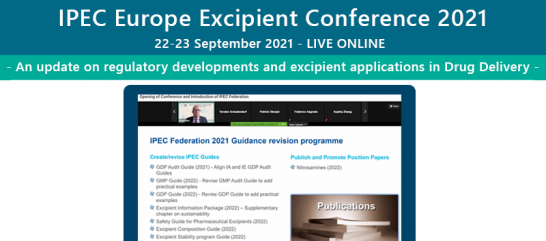
The ninth edition of the IPEC Europe Excipient Conference - organised by IPEC Europe and the International Association for Pharmaceutical Technology (APV) - was a great success with around 70 participants over the two-days of virtual event.
Representatives of pharmaceutical manufacturers, excipient suppliers, regulatory authorities and other stakeholders gathered virtually on the afternoons of 22 and 23 September to hear the latest developments on a number of hot topics relevant to pharmaceutical excipients.
To re-live the presentations, please click here: IPEC Europe Excipient Conference 2021. The dossier with the presentations is available in the Member's Lab, under Members.
Day one of the event provided a comprehensive appraisal of the current regulatory environment for excipients and started with a presentation by Frithjof Holtz, Chair of IPEC Europe and Regulatory Intelligence for Merck KGaA, who looked at the evolution of excipient in Europe from a supply perspective. Thus far, the legislation directly applicable is limited; the introduction of appropriate Good Manufacturing Practice (GMP) requirements for all excipients as laid down by Falsified Medicines Directive (2011/62/EU) put excipients in the spotlight. Excipients, in particular novel excipients, play an increasing role in drug dosage delivery and efficacy; this will drive more interest in their quality and safety implications.
After that, Dr. Dirk Leutner of the European Directorate for the Quality of Medicines and Healthcare (EDQM) discussed how the Ph. Eur. is facilitating continuous manufacturing via quality-by-design concepts and process-analytical technology. Harmonisation efforts through the Pharmacopoeial Discussion Group (PDG) continued during the recent pandemic and several tests, incl. general chapters on elemental impurity, are planned to be finalised by 2022. All newly sign-off texts are accessible on the PDG pharmacopoeial members’ websites. New Ph.Eur. General Chapters under elaboration are the Implementation of pharmacopoeial procedures (5.26) and Comparability testing of alternative methods (5.27).
Looking back, Chris Moreton, Ph.D. of FinnBrit Consulting reviewed the concepts discussed in a 1996 paper and listed the most remarkable developments in the world of excipients over the past 25 years. To name a few, Quality-by-Design has been probably the most significant change in formulation design and development, and the Falsified Medicines Directive had a far-reaching effect in Europe on the need to assess appropriate GMPs for excipients.
According to Moreton, the current range of excipients is not sufficient to satisfy the needs of the pharmaceutical industry and more action is needed, highlighting the absence of a dedicated regulatory approval system, the lack of a more rational risk-based approach to safety-toxicity testing, and the need to have intellectual property protection equivalent to that for drug molecules. Other challenges which may impact excipients include potential restrictions on microplastics and Titanium Dioxide, with a potential disruptive effect on the supply of medicines to patients.
Up next, Galina Holloway, Ph.D. provided perspectives of the US Pharmacopoeia on setting compendial specifications for Excipient Composition and Impurities. The Stimuli Article published in PF 44(3) in 2018 noted the challenges for setting specifications for excipients, and shared the definitions of simple and complex excipients, excipient composition and impurity. The surveys conducted in 2018 and 2021 focused on understanding the importance and impact of establishing compositional and impurities specifications in excipient monographs. On the subject of elemental impurities, Holloway updated attendees on the principles and approaches of the (first draft) Roadmap to address the testing in excipients, the input received from stakeholders in the development of the Roadmap and the multistep approach proposed. A subcommittee on Excipient Composition and Impurities has been created to review and evaluate the principles and approaches presented in the Stimuli Article and the Roadmap, and to develop a work plan with opportunities for a collaborative work with stakeholders.
To round off the day, Dave Schoneker, Black Diamond Regulatory Consulting, LLC, provided a thorough overview of the regulatory framework for excipients in Latin America and India. South American countries do not have specific regulations for excipients, except Brazil and Peru, though excipients with a monograph in a reference compendia are generally accepted. In Mexico, regulation applies the same sanitary rules for drugs to excipients. Regulators from the Andes Region tend to align with FDA and EMA rather than with the ANVISA authority. Drug regulatory agencies in India do not impose specific regulations for excipients nor restrictions on quantity imported. The local FDA can control only excipients that claim or are included in the Indian Pharmacopoeia; if an IP monograph is absent, compliance to any other major pharmacopoeia is acceptable. If claimed to be IP quality, excipients manufactured locally need to be registered with the local State FDA; there are no major restrictions on the import of excipients except for atypical actives, for which registration with DCGI and clearance on importation is needed.
The second day of the event focused on scientific and technology topics. Starting the session Prof. Andreas Bernkop-Schnürch (University of Innsbruck, Austria) presented on three ways to prolong intraoral residence time, which improves therapeutic efficacy for numerous drugs such as anti-inflammatories, antiseptics, antibiotics and antimycotics. Both the use of mucoadhesive polymers and the self-emulsifying drug delivery systems (SEDDS) allow up to ten-fold prolonged drug residence time. Polymers adhere to mucus via secondary bonds and chain entanglements, and controlled release is provided via secondary bonds, while SEDDS penetrate the mucus gel layer. A third method, explained Dr. Bernkop-Schnuerch, would be the use of thiolated cyclodextrins, which adhere via disulfide bond formation with mucus, and controlled release is provided by the hydrophobic cavity. Poised to be the next generation of mucoadhesives and promising to provide a ten to twenty-fold prolonged drug residence time, are thiolated CDs which as yet have not been registered as excipients.
On the role of Excipients in topical drug delivery systems, Dr. Michael Herbig, RaDes GmbH, provided a formulator’s perspective that a good understanding of excipient functionality helps to build the basis for a Quality-by-Design approach for topical formulation development. Efficacy can be indirectly and directly influenced by excipients. The resulting strategic considerations should be evaluated early on in development.The actual functionality of the excipient needs to be evaluated during formulation based on physical and chemical understanding of the formulation. Herbig added that the impact of the variability of excipients used topically needs to be assessed: in many cases, it will be possible to accommodate variability in the design of the formulation, while for others, a customer specification needs to be established.
Liz Meehan, Ph.D. of AstraZeneca addressed Continuous Manufacturing (CM) for solid oral dosage forms, an area of growing interest and importance for the pharmaceutical sector. So far, relatively few products have been marketed but this is likely to expand rapidly over the coming years. Continuous Manufacturing places an emphasis on understanding material attributes, including excipients as well as the API, and how they interact with continuous process parameters to ensure that drug product critical quality attributes are delivered. Regulatory expectations are still evolving but established principles of science and risk-based pharmaceutical development still apply (ICH Q8/Q9). Close collaboration between suppliers and users of excipients is beneficial during development, to be able to prepare robust regulatory filings for Continuous Manufacturing-made products.
Finally, Edmont Stoyanov from Nisso Chemical updated the participants with a presentation on 3D printing of opioid medicines with alcohol-resistant and abuse-deterrent properties. 3D printing enables the fabrication of personalised doses to create abuse-deterrent tablets with modified release properties to minimise the prevalence and risks of opioid abuse. Stoyanov reported on the preparation of modified release tramadol printlets (3D printed tablets) with alcohol-resistant and abuse-deterrent properties by direct powder extrusion three-dimensional (3D) printing. The printlets were fabricated using two grades of hydroxypropylcellulose (HPC). Both formulations displayed strong ethanol-resistance and had moderate abuse-deterrent properties. The addition of Polyethylene oxide (PEO) in the formulations improved the printlets’ resistance to physical tampering in nasal inhalation tests and delayed their dissolution in solvent extraction tests.
Save the Date for the 10th Edition of the Conference which will be held in Frankfurt am Main (Germany) on 27 and 28 September 2022.
External Events: Making Pharmaceuticals UK, EuPFI
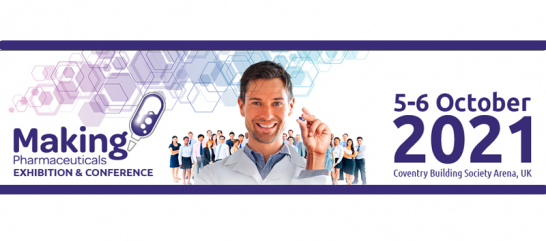
Making Pharmaceuticals UK
IPEC Europe attended the Making Pharmaceuticals event in Coventry, UK, on 5-6 October and took a leading role in the conference sessions focused on excipients. The Making Pharmaceuticals event is a free-to-attend event and was a great showcase as it attracted a very good flow of visitors over the two days, helping IPEC Europe to spread the word on its activities to a tailored audience of professionals involved in pharma manufacturing.
Board member Kevin Hughes (Colorcon), EXCiPACT President Iain Moore (Croda) and IPEC Europe Senior Advisor Adrian Bone presented to an audience of pharmaceutical experts on the best practices for the selection of excipients for paediatrics, the need for and issues with introducing new excipients to the market, and the IPEC Co-processed excipient Guide. The seminar sessions were well attended, and there was good interaction from the audience, some of whom stayed on afterwards to continue discussions.
Visitors also came to the IPEC Europe/EXCiPACT stand where Adrian Bone, our Senior Advisor, answered questions and provided more information on IPEC Europe and its activities.
EuPFI
The European Paediatric Formulation Initiative (EuPFI) held the 13th Annual (virtual) conference on ‘Formulating better medicines for children’ on 22-23 September 2021.
The goal of this event was to shed light on key issues when developing medicines for children that meet the needs of the patient, prescriber and regulator and to highlight the place of paediatric issues in drug development.
In its journey of successfully navigating the road on its mission to developing better and safe medicines for children, EuPFI 2021 provided an opportunity to advance knowledge and understanding in the areas where the needs of adult and paediatric patients overlap, where they differ and also area of diseases that occur mainly in children.
Developments in global pharmaceutical excipients in the next 3–5 years
By Iain Moore, Head of Global Quality Assurance, Croda, and President of EXCiPACT®
Excipients have always played a critical role in the safe and effective use of medicinal products. Their functions range from acting simply as a bulking agent to allow a tiny quantity of an active to be picked up by the patient right through to being responsible for forming the lipid nanoparticles that deliver the mRNA in several COVID-19 vaccines.
And, whereas they are pharmacologically inactive, in that they have no therapeutic effect on their own, the oversight applied to them in the drug product approval process can be as rigorous as the active substance.
In the developed world, the ways of using and approving excipients are well established and have changed very little in the past decade. The newly emerging economies, however, are now introducing new and more demanding ways of approving the manufacture and use of excipients — and these developments are driving changes throughout the industry.
Pharmacopoeia
Traditional excipients have been used for decades in many drug product formulations with a correspondingly large amount of information demonstrating their safe and effective use.
This allows the quality of such excipients to be well defined in the various pharmacopoeial monographs, simplifying the regulatory approval of new drug products that use these excipients.
This comfortable arrangement has been in place for a long time; however, it makes the introduction of structural change extremely difficult, as exemplified by the low incidence of novel excipients and the poor progress in monograph harmonisation.
Previously, the slow pace of change allowed for economically motivated adulteration by unscrupulous actors in the early years of this century.
As a result, there has been a drive to update pharmacopoeial monographs to make use of modern analytical techniques to allow for a much more precise definition of the quality and purity of the excipients.
This trend must continue … not least to ensure patient safety through analytical accuracy and improved understanding of the excipient composition, but also to stop using ancient test methods that require the use of environmentally damaging reagents.
The new economies are developing their own pharmacopoeial monographs quickly, none more so than China. Whereas the monographs for the traditional excipients that are availably globally may include more modern analytical techniques, there has been further divergence from the established monographs.
If the previous difficulties in achieving monograph harmonisation in the developed world were already exceptionally difficult, then the introduction of more national pharmacopoeia with their own subtle differences will make that all but impossible.
In this regard, it is hard to see how the next few years are going to see much progress in the harmonisation of excipient monographs without a shift away from the nationalistic viewpoint.
Impurities
As they can often contain several components that are critical to the overall function, it is becoming more and more important to have a better understanding of excipient composition.
It would be incorrect to consider these components as impurities. We can therefore expect to see more scrutiny about overall excipient composition with the objective of having a better definition of the intended composition.
However, excipients have been recognised as contributing to the overall level of impurities in a drug product and, as such, are under increasing regulatory examination.
Excipients were explicitly referenced in the ICH Q3D guideline on Elemental Impurities, even though it was demonstrated that there was no systematic problem with excipients in this case.
However, the same is not true when it comes to nitrosamine impurities, wherein the levels of patient concern are three orders of magnitude lower than what was previously an acceptable level for an impurity. It is now clear that excipients may and can contribute to the formation of nitrosamines in susceptible drug products.
Thus, we can anticipate that as scientific knowledge advances, more details will need to be shared about excipient composition profile, and this will require the excipient supplier to control the quality of their excipient accordingly.
Whereas some impurity issues are clearly driven by a demonstrable need to ensure patient safety, other developments in the control of excipient quality will be driven by the need for sustainability.
Microplastics and concerns about endocrine disruptors are two contemporary topics … but we can expect more of this nature in the next few years. Some of these issues will be driven by the science; but, unfortunately, others will be placed on the agenda by political, social and other pressures.
Regulations
There have been few recent regulations in the developed economies concerning excipients. The most significant was the EU ascertaining GMP guidelines for excipients, which required users to perform a risk assessment to determine the appropriate GMP required for the manufacture of the excipient in their drug product. The fact this has been adopted by PIC/S now makes it global best practice.
Of greatest significance in this document was the approach away from telling industry “what to do” in a prescriptive set of rules towards a position whereby the excipient user had to use logic and good science to justify their decision about the GMP required for the manufacture of the excipient.
This is a significant milestone, and it is to be hoped that the approach can be utilised further in other aspects of the industry, especially as drug products become more and more complex.
This document should also readily accommodate advanced manufacturing techniques, which are being developed alongside Industry 4.0 and may otherwise have been incompatible with traditional GMP definitions. In this respect, this will allow for more innovation in traditional excipient manufacturing.
The GMP guide also specifically stipulated that excipient supplier certification (to a GMP standard such as EXCiPACT, for example) could be used to demonstrate that manufacturers were applying the correct standards during production.
Such a development has been put to a lot of use during the pandemic, and there is no reason to suppose that when matters adjust to the “new normal” that there will be a return to widespread international auditing.
There will also be another driver here to reduce travel, and that is the need to reduce carbon emissions.
In the developed world, this guide represents the definition of GMP for excipients; but, in the developing world, new specific guides are being introduced that set GMP standards that are much closer to ICH Q7 in principle and details.
This may yet be counterproductive as it will deter some suppliers from making their excipients available in those countries because of the investment required to bring their existing GMP level up to that of full pharmaceutical standards.
These pressures will mean that more excipients will be expressly manufactured for use in pharmaceuticals and not be substances made for other purposes that “happen” to be sold for use in drug products.
Innovation
Despite the barriers to the introduction of truly novel excipients, some innovation has been possible with the introduction of coprocessed excipients and excipient blends.
These mixtures can offer new properties to the drug product, especially in solid dosage forms and thus aid the availability of the active.
However, there has been a view by some regulatory authorities that any mixture of excipients that is not required to ensure the stability of the excipient in the supply chain is actually the first part of drug product formulation and therefore has to be performed under full drug product GMPs.
Again, the investments needed for the excipient supplier to meet such standards are disproportionate to the risks to patient safety, so these materials will become increasingly unavailable unless there is some adjustment of the regulatory position.
Truly novel chemical entities that have been designed and manufactured as pharmaceutical excipients are exceptionally rare. The few examples in the recent past have incurred very large development costs, not least in the demonstration of patient safety, and have been underutilised by the pharmaceutical industry.
Why would you formulate with a novel excipient knowing the regulatory scrutiny of the marketing authorisation dossier may trigger additional questions and delays when using a traditional excipient would not incur such questions … even if it did not perform as well?
This is another block to the development of new therapeutic approaches, especially using biopharmaceuticals (“big molecules”), which often require new excipients with novel properties.
An excellent example are the polar lipids used to encapsulate the mRNA in COVID-19 vaccines. Indeed, without these excipients, there would have been no effective vaccine using mRNA.
The acute need for a successful vaccine outweighed any reluctance to use novel excipients, which allowed all parties — the excipient manufacturer, the vaccine maker and the regulatory authorities — to take pragmatic steps to accelerate the use and approval of these substances.
The US FDA now acknowledges that the lack of novel excipients is indeed a problem, noting the limitations of existing excipients in some drug product scenarios.
On 7 September 2021, they announced the Novel Excipient Review Pilot Program. This will select and then review four novel excipients in the next 2 years using a new pathway.
This will allow manufacturers to obtain an FDA review prior to the use of the novel excipient in a drug formulation. Note, though, that this is not an excipient approval process; the novel excipient would still be evaluated as part of the overall drug product approval.
In Europe, the absence of an excipient master file system is a specific problem that means the only way to introduce a novel excipient is via the marketing authorisation dossier; therefore, all information about the excipient has to be shared with the pharmaceutical manufacturer, including all the intellectual property invested in the new excipient.
At least in the US, Canada, Japan and now China, excipient master files exist that allow some protection of the excipient manufacturer’s intellectual property. So, we can expect to see novel excipients used first in these regions — at the expense of patients in Europe who may miss out on new therapies.
For novel excipients, one pathway is clear; as these are intended to be used in pharmaceutical drug products and have not been repurposed from other applications, the GMPs to be applied may have to be more akin to ICH Q7 for actives than for traditional excipients.
This is in accordance with the previously mentioned ascertaining GMP risk assessment guide; as there is less knowledge about the manufacture and use of novel excipients, higher standards may be required to mitigate the risks.
If there is one bright spot with regards to novel excipients, then the new lipids used to encapsulate mRNA vaccines can be repurposed to perform the same duty with other actives that require the same delivery mechanisms.
This multiple application of a novel excipient could be a blueprint for further introductions. Rather than designing one for a certain drug product, it is designed for a specific purpose and hence can be applied to multiple drug products.
Consequently, some of the risks of developing and introducing the novel excipient can be mitigated. The success of this strategy has been proven, so we can expect others to follow.
Economics
The pandemic and, perhaps more so, its aftermath with the acute disruption of global supply chains has brought the risks of sourcing materials for drug products on a worldwide scale into sharp focus.
The natural reaction will be to redress the risks by obtaining excipients more locally, with cost savings by sourcing more remotely being demoted in priority. How long this trend lasts will depend on how long lasting the pandemic and its repercussions will be, but the adjustments are likely to be permanent for the most critical drug products (especially COVID-19 vaccines).
Many excipients were not designed for drug products and were designed for use in other industries, such as food, cosmetics, etc. This position is being eroded and we can expect to see more and more of the traditional excipients being manufactured exclusively for pharmaceutical use.
It is possible that a few suppliers will take the lead in this and that, as a result, the number of suppliers will decrease in the coming years. Subsequently, closer collaborations between excipients suppliers and users will develop from what is often a very distant relationship.
Sustainability
The awful human tragedy associated with the COVID-19 pandemic is not the only global crisis of our times; that of global warming and its consequences will also have a damaging impact on human lives as the current news programmes continue to show.
Other industries are taking the brunt of attention in decarbonising, but there is a slow groundswell within the pharmaceutical industry that will gain momentum in the next 3–5 years.
Initial steps may include removing environmentally hazardous and toxic substances from the manufacture and testing of drug products, and more frequent use of remote and third-party auditing.
The next steps will involve the principles of the circular economy in all aspects of the industry, including excipients. Here substitutions from fossil-based substances to sustainably sourced ones will have to be found, and this will pose a number of scientific challenges — not least ensuring the replacements have the same or better quality, purity and patient safety profiles.
Such changes are going to be applied externally to the industry and are likely to be led by both government and social influences.
Conclusions
The very nature of the industry puts patient safety first and foremost, and rightly so. This makes change in the developed world rather slow and measured.
Yet, the emerging economies, unencumbered by a well-oiled infrastructure, are forging ahead with new standards and ways of dealing with excipients. The pandemic too has demonstrated that a much faster pace of change does not mean that patient safety has to be compromised.
In the next 3–5 years, we can therefore expect to see an acceleration of the existing trends that examine the composition and purity of excipients in ever more detail, as well as the emergence of sustainability as an important factor.
Supply chain perturbations owing to the pandemic may turn out to be transitory, unless political factors also weigh in; the economics of a low-cost supplier will usually win in the end.
Additionally, significant barriers to the introduction of novel excipients remain, despite the success with those utilised in mRNA-based COVID-19 vaccines.
In this regard, Europe is at a distinct disadvantage in the protection of the excipient manufacturer’s intellectual property, and so could well miss out on new therapies using novel excipients, delaying patient access.
Regardless of these changes and challenges, we can be assured that excipients will continue to be a critical component of the success of drug products.
Acknowledgements
My thanks to all those individuals in trade associations and elsewhere who have been patient with me and allowed me to learn so much about excipients and their role in drug products. In particular, special thanks to those who contributed their thoughts and helped to proof this article.
This article was originally published in the CPhI Annual Report 2021 and is reproduced with kind permission.
Calendar
|
Group
|
2021
|
|
IPEC Europe Board
|
24 November
|
|
Good Distribution Practices Committee
|
27-28 October
|
|
Quality & Regulatory Affairs Committee
|
16 December
|
| Co-processed Excipients TF |
12 October |
| Lactose Interest Group |
14 October |
| Catch-up on IPEC Activities - Q4 |
9 December |
All meetings will be held online unless mentioned otherwise.
Do you wish to join a Committee or a Task Force? Please contact the IPEC Europe Secretariat.
Events
Here’s a round-up of forthcoming events of interest to suppliers and users of excipients. Please let the IPEC Europe Secretariat know if we've missed anything!
Q4 2021
APIC/CEFIC Global GMP & Regulatory API Conference
Berlin, Germany / live online - 26-28 October 2021
More information here
2020 ISPE Annual Meeting & Expo
Boston, MA, USA – 1-3 November 2021
More information here
Santexpo 2021
Paris, France - 8-10 November 2021
More information here
CPhI Worldwide
Milan, Italy – 9-11 November 2021
More information here
2022
IPEC Europe Annual Excipients Forum
Location to be announced – late March 2022
Visit our website
Exciperience
Online event - 9-10 March 2022
More information here
PBP World Meeting
Rotterdam, The Netherlands – 28-31 March 2022
More information here
Excipient World 2022
Kissimmee, FL, USA - 2-4 May 2022
More information here
Chemspec Europe
Frankfurt, Germany – 31 May – 1 June 2022
More information here
POWTECH 2022
Nuremberg, Germany - 30 August - 1 September 2022
More information here
IPEC Europe Excipient Conference 2022
Frankfurt, Germany – 27-28 September 2022
|